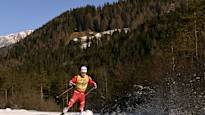When ski competitions are organized in two locations, the event has nothing to do with the word tour, writes Atte Husu.
Atte Husuurheilu reporter
It’s been a long time since the turn of the year 2006-2007.
That sums up my first thought when I heard about this year’s Tour de Ski.
19 years ago ski bosses marketed the debut tour as a joint ten-day effort by the Czech Republic, Germany, Switzerland and Italy. Today, only remnants of the original brand remain.
When the Tour de Ski was first mentioned, it was referred to as the Tour de France of skiing. The Tour de France, or Tour of France in Finnish, is an iconic cycling competition organized since 1903, which in its most recent version covered 21 stages. In 20 of them, the finish was in a different city than the start.
Shirts with each year’s tour locations on the map are a sought-after item among sports fans. Just by looking at the t-shirt, it is possible to realize that the dashed line depicting the race route between the tour locations corresponds to thousands of kilometers in real life. A total of 3,498 of them were collected in the 2024 race.
You wouldn’t get a chart hit from the tour shirt of the Tour de Ski held at the turn of the year. In this year’s event, the first four races were held in Toblach, from where the teams traveled 140 kilometers by car to Val di Fiemme, which organized the remaining three stages.
The change from last years is big, because in the second season the Tour visited Switzerland, Germany and Italy. Last season, Germany hit the counter, and this year Switzerland followed suit.
At this point, everyone who follows skiing can certainly state with their heart that this year’s Tour was anything but what the ski bosses painted for sports people recently.
All that’s left of it is the name, for which this entire entity was, to put it mildly, a shame.
Second level competition
The problem with the Tour de Ski since the beginning has been its timing and value.
During the prize competition years, especially among women, several top skiers have left the Tour completely or interrupted it in a planned way.
During the Tour’s existence, there have been four Winter Olympics, where 16 individual gold medals have been awarded. In women, only Poland Justyna Kowalczyk has been able to achieve a personal Olympic gold after reaching the top of the final climb of Alpe Cermis, which ends the Tour a few weeks earlier.
The Tour de Ski is an annual event in the papers of the brightest stars, which you don’t have to think about missing for a second, if participating could threaten the preparation for prestigious competitions. That’s not what the Tour de France is for cyclists.
The credibility of the Tour de Ski is also eroded year after year by the lack of spectators. In terms of the number of spectators, the competitions are at a low level compared to, for example, the World Cups held in the Nordic countries, although in the history of the Tour, spectators have not had to pay a single euro to be able to watch the Toblach races on the side of the track, anywhere in the finish area.
In Italy, the ski pass is paid for by tourism companies, for whom the Tour’s competitions are a cheap way to advertise the picturesque natural landscapes, considering the size of the business – whether there is an audience or not.
Good races
Even though this year’s Tour de Ski was a mockery of the original creation, the tension in both women and men was commendably maintained until the end of the event.
In women Therese Johaug only decided the game last in the previous stage, and even in men Johannes Hösloft Kläbo dominated the overall race as he wanted, behind him there was a tough fight for the prize places on the slopes of Alpe Cermis.
Especially in the years of value races, some of the top athletes have avoided the Tour or skied only a part of it. The background has been the desire to avoid strenuous travel, which increases the risk of getting sick.
The suspension in two locations did not bring a significant change to previous years in terms of suspensions. Of the 64 women who started the opening stage in Toblach, 31 climbed the final climb that ended the tour, which is the third lowest number in the history of the Tour.
The International Skiing Federation FIS has been pushing the current model for athletes for almost 20 years without any signs of growth compared to the starting level. So, is it time to try something new, ski decision makers?
